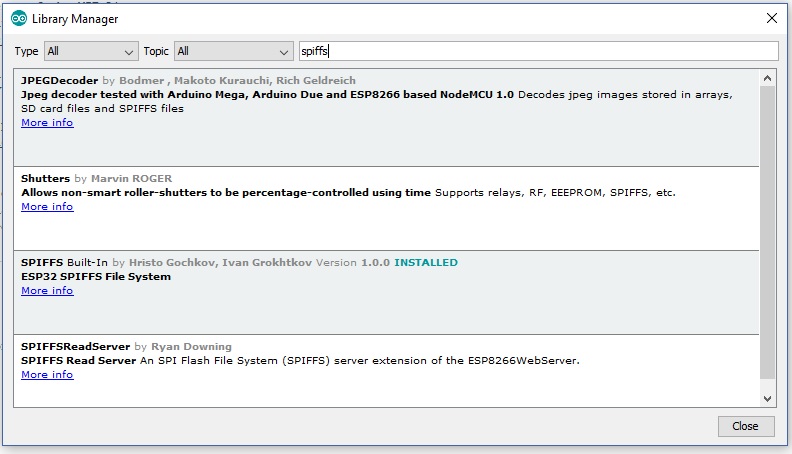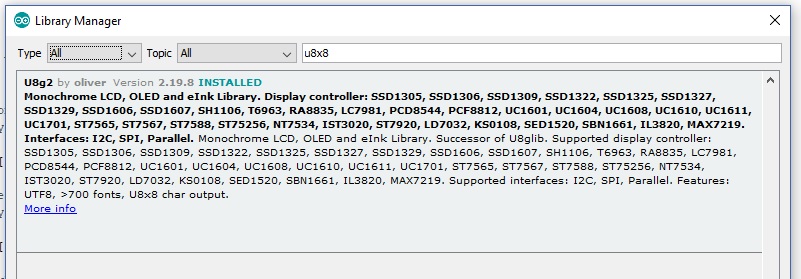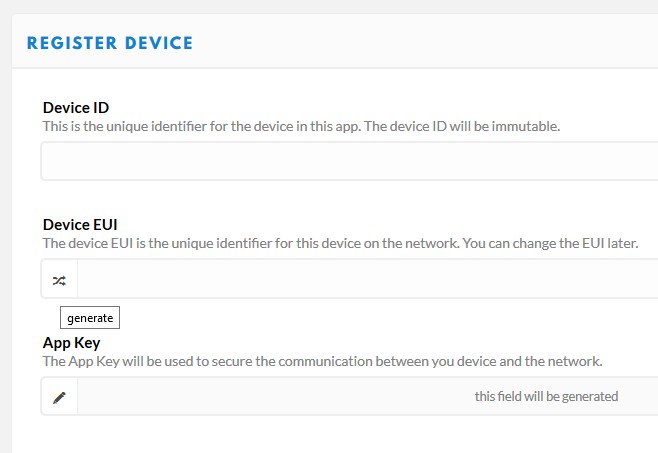Ok, I removed the usb-uart cp210x.
Still 2.6 mA.
Note that the board is much lighter now ^^ Better for IoT 
Ok, I removed the usb-uart cp210x.
Still 2.6 mA.
Note that the board is much lighter now ^^ Better for IoT 
Does somebody has the documentation of this board.
I received mine. As far as I understood the small- coil soldered antenna is for WIFI / BT while the IPX connector is for LoRa.
Now the tricky part - The Lora receive level with or without attached antenna are the same - 108dbm
I have used
IPX-SMA cable 15…20cm - https://www.ebay.com/itm/20cm-RG178-Cable-RP-SMA-Female-Plug-Bulkhead-To-IPX-U-FL-Coax-Pigtail-8in-BS1/262569476561?hash=item3d225c41d1:g:xmYAAOSwoydWm9xh
this type of antenna - https://www.ebay.com/itm/4pcs-lot-Ebyte-868mhz-TX868-JZ-5-2-5dBi-high-gain-SMA-Male-rf-rubber-antenna/192237275389?hash=item2cc23c08fd:g:dpsAAOSw2xRYYxVt
setup - At home , transmitter at second floor receiver basement.
Can somebody confirm the purpose of two antennas?
thanks
** 4/12/17 - Altered to take into account what Kersing says below
** 7/12/17 - Altered to take into account the installation of libraries that may not already be installed and to add sister TX code
** 15/12/17 - Altrered to add info on how to copy the 3 codes from console
Thanks @Kersing
Got the single channel gateway working on my Heltec WiFi LoRa 32 (with OLED display)
https://www.aliexpress.com/item/868MHz-915MHz-SX1276-ESP32-LoRa-0-96-Inch-OLED-Display-Bluetooth-WIFI-Lora-Kit-32-Module/32835492243.html?ws_ab_test=searchweb0_0,searchweb201602_1_10152_10065_10151_10344_10068_10130_10345_10324_10342_10547_10325_10343_10340_10341_10548_10192_10541_10190_10084_10083_10307_10301_10303_10539_10312_10059_10313_10314_10184_10534_100031_10604_10603_10103_10605_10594_10596_10142_10107,searchweb201603_25,ppcSwitch_5&algo_expid=2ba45802-8bfd-4728-b9ca-e592aea6c379-19&algo_pvid=2ba45802-8bfd-4728-b9ca-e592aea6c379&rmStoreLevelAB=5
Very nice
Just listing the things I did to get it working (hopefully useful for others)
1 Gateway Ident definitions
(description, Lat long)
2 ntp
(for UK, change to NTP_TIMESERVER “uk.pool.ntp.org” and NTP_TIMEZONES 0
3 definition of wpas wpa[]
Change code from this:
#if 0
wpas wpa[] = {
{ “” , “” }, // Reserved for WiFi Manager
{ “ape”, “apePasswd” }
{ “ape”, “apePasswd” }
};
#else
Place outside version control to avoid the risk of commiting it to github 
#include “d:\arduino\wpa.h”
#endif
to this
wpas wpa[] = {
{ “” , “” }, // Reserved for WiFi Manager
{ “YOUR WIFI SSID”, “YOUR WIFI SSID PASSWORD” }
};
Execute the Arduino IDE
Ensure you have installed both the SPIFFS and U8G2 libraries as shown (ignore the others shown in this pic) using “Sketch->Include Library->Manage Libraries”


Upload the sketch via “File->Examples->ESP-sc-gway”. Set up the port and upload into your Heltec WiFi LoRa 32 device, (when the device re-boots, you should see info displayed on the OLED)
When the device has booted and logged into your wifi network, find the IP address it is using from your router and enter this IP address into a web browser to display a webpage of Gateway details - note the 8 byte “Gateway ID” (you need this for the TTN console)
Log into the TTN console and setup a new gateway - You need to tick the “I’m using the legacy packet forwarder” checkbox and paste the 8 byte “Gateway ID” seen from the webpage.
setup a few other things like frequency and save!
thats it - amazing !!!
Copy and paste the preformatted text seen below into the Arduino IDE.
The 3 lines that need changing are prefixed with “$$”. Remove the “$$” and replace the code using info defined in TTN - remember that in TTN, you can only switch the device from OTAA to ABP after you have saved the device in TTN!!! Once the device has been changed to “ABP”, you will then see the 3 codes in the console that you need to copy back to the Arduino code. i.e.
For DEVADDR/Device Address - just copy the hex and add after the 0x in the code
For NWKSKEY and APPSKEY - click the eye (show code) then the <> (C-style), click the “copy” button and then use that to paste into the code (do not press the ⇆ button and check that your showing MSB before copying!)
/*******************************************************************************
* Copyright (c) 2015 Thomas Telkamp and Matthijs Kooijman
* adapted by Curlywurly to use LCD
* Permission is hereby granted, free of charge, to anyone
* obtaining a copy of this document and accompanying files,
* to do whatever they want with them without any restriction,
* including, but not limited to, copying, modification and redistribution.
* NO WARRANTY OF ANY KIND IS PROVIDED.
*
* This example sends a valid LoRaWAN packet with payload "Hello,
* world!", using frequency and encryption settings matching those of
* the The Things Network.
*
* This uses ABP (Activation-by-personalisation), where a DevAddr and
* Session keys are preconfigured (unlike OTAA, where a DevEUI and
* application key is configured, while the DevAddr and session keys are
* assigned/generated in the over-the-air-activation procedure).
*
* Note: LoRaWAN per sub-band duty-cycle limitation is enforced (1% in
* g1, 0.1% in g2), but not the TTN fair usage policy (which is probably
* violated by this sketch when left running for longer)!
*
* To use this sketch, first register your application and device with
* the things network, to set or generate a DevAddr, NwkSKey and
* AppSKey. Each device should have their own unique values for these
* fields.
*
* Do not forget to define the radio type correctly in config.h.
*
*******************************************************************************/
#include <lmic.h>
#include <hal/hal.h>
#include <SPI.h>
#include <U8x8lib.h>
#define BUILTIN_LED 25
// the OLED used
U8X8_SSD1306_128X64_NONAME_SW_I2C u8x8(/* clock=*/ 15, /* data=*/ 4, /* reset=*/ 16);
// LoRaWAN NwkSKey, network session key
// This is the default Semtech key, which is used by the early prototype TTN
// network.
$$static const PROGMEM u1_t NWKSKEY[16] = { 0xAA, 0xCE, 0x88, 0x69, 0x05, 0xC6, 0xCE, 0xEF, 0x33, 0xF4, 0x76, 0xDC, 0xDC, 0x77, 0x67, 0x9F };
// LoRaWAN AppSKey, application session key
// This is the default Semtech key, which is used by the early prototype TTN
// network.
$$static const u1_t PROGMEM APPSKEY[16] = { 0x86, 0xF9, 0xB8, 0xC6, 0x69, 0x70, 0x63, 0x37, 0xCA, 0x12, 0xE0, 0x8D, 0xFF, 0xEC, 0x6A, 0xAA };
// LoRaWAN end-device address (DevAddr)
$$static const u4_t DEVADDR = 0x310313D8 ; // <-- Change this address for every node!
// These callbacks are only used in over-the-air activation, so they are
// left empty here (we cannot leave them out completely unless
// DISABLE_JOIN is set in config.h, otherwise the linker will complain).
void os_getArtEui (u1_t* buf) { }
void os_getDevEui (u1_t* buf) { }
void os_getDevKey (u1_t* buf) { }
static uint8_t mydata[] = "Hi!";
static osjob_t sendjob;
// Schedule TX every this many seconds (might become longer due to duty
// cycle limitations).
const unsigned TX_INTERVAL = 10;
// Pin mapping
const lmic_pinmap lmic_pins = {
.nss = 18,
.rxtx = LMIC_UNUSED_PIN,
.rst = 14,
.dio = {26, 33, 32},
};
void onEvent (ev_t ev) {
Serial.print(os_getTime());
u8x8.setCursor(0, 5);
u8x8.printf("TIME %lu", os_getTime());
Serial.print(": ");
switch(ev) {
case EV_SCAN_TIMEOUT:
Serial.println(F("EV_SCAN_TIMEOUT"));
u8x8.drawString(0, 7, "EV_SCAN_TIMEOUT");
break;
case EV_BEACON_FOUND:
Serial.println(F("EV_BEACON_FOUND"));
u8x8.drawString(0, 7, "EV_BEACON_FOUND");
break;
case EV_BEACON_MISSED:
Serial.println(F("EV_BEACON_MISSED"));
u8x8.drawString(0, 7, "EV_BEACON_MISSED");
break;
case EV_BEACON_TRACKED:
Serial.println(F("EV_BEACON_TRACKED"));
u8x8.drawString(0, 7, "EV_BEACON_TRACKED");
break;
case EV_JOINING:
Serial.println(F("EV_JOINING"));
u8x8.drawString(0, 7, "EV_JOINING");
break;
case EV_JOINED:
Serial.println(F("EV_JOINED"));
u8x8.drawString(0, 7, "EV_JOINED ");
break;
case EV_RFU1:
Serial.println(F("EV_RFU1"));
u8x8.drawString(0, 7, "EV_RFUI");
break;
case EV_JOIN_FAILED:
Serial.println(F("EV_JOIN_FAILED"));
u8x8.drawString(0, 7, "EV_JOIN_FAILED");
break;
case EV_REJOIN_FAILED:
Serial.println(F("EV_REJOIN_FAILED"));
u8x8.drawString(0, 7, "EV_REJOIN_FAILED");
break;
case EV_TXCOMPLETE:
Serial.println(F("EV_TXCOMPLETE (includes waiting for RX windows)"));
u8x8.drawString(0, 7, "EV_TXCOMPLETE");
digitalWrite(BUILTIN_LED, LOW);
if (LMIC.txrxFlags & TXRX_ACK)
Serial.println(F("Received ack"));
u8x8.drawString(0, 7, "Received ACK");
if (LMIC.dataLen) {
Serial.println(F("Received "));
u8x8.drawString(0, 6, "RX ");
Serial.println(LMIC.dataLen);
u8x8.setCursor(4, 6);
u8x8.printf("%i bytes", LMIC.dataLen);
Serial.println(F(" bytes of payload"));
u8x8.setCursor(0, 7);
u8x8.printf("RSSI %d SNR %.1d", LMIC.rssi, LMIC.snr);
}
// Schedule next transmission
os_setTimedCallback(&sendjob, os_getTime()+sec2osticks(TX_INTERVAL), do_send);
break;
case EV_LOST_TSYNC:
Serial.println(F("EV_LOST_TSYNC"));
u8x8.drawString(0, 7, "EV_LOST_TSYNC");
break;
case EV_RESET:
Serial.println(F("EV_RESET"));
u8x8.drawString(0, 7, "EV_RESET");
break;
case EV_RXCOMPLETE:
// data received in ping slot
Serial.println(F("EV_RXCOMPLETE"));
u8x8.drawString(0, 7, "EV_RXCOMPLETE");
break;
case EV_LINK_DEAD:
Serial.println(F("EV_LINK_DEAD"));
u8x8.drawString(0, 7, "EV_LINK_DEAD");
break;
case EV_LINK_ALIVE:
Serial.println(F("EV_LINK_ALIVE"));
u8x8.drawString(0, 7, "EV_LINK_ALIVE");
break;
default:
Serial.println(F("Unknown event"));
u8x8.setCursor(0, 7);
u8x8.printf("UNKNOWN EVENT %d", ev);
break;
}
}
void do_send(osjob_t* j){
// Check if there is not a current TX/RX job running
if (LMIC.opmode & OP_TXRXPEND) {
Serial.println(F("OP_TXRXPEND, not sending"));
u8x8.drawString(0, 7, "OP_TXRXPEND, not sent");
} else {
// Prepare upstream data transmission at the next possible time.
LMIC_setTxData2(1, mydata, sizeof(mydata)-1, 0);
Serial.println(F("Packet queued"));
u8x8.drawString(0, 7, "PACKET QUEUED");
digitalWrite(BUILTIN_LED, HIGH);
}
// Next TX is scheduled after TX_COMPLETE event.
}
void setup() {
Serial.begin(115200);
Serial.println(F("Starting"));
u8x8.begin();
u8x8.setFont(u8x8_font_chroma48medium8_r);
u8x8.drawString(0, 1, "HelTec TX LMiC");
#ifdef VCC_ENABLE
// For Pinoccio Scout boards
pinMode(VCC_ENABLE, OUTPUT);
digitalWrite(VCC_ENABLE, HIGH);
delay(1000);
#endif
SPI.begin(5, 19, 27);
// LMIC init
os_init();
// Reset the MAC state. Session and pending data transfers will be discarded.
LMIC_reset();
// Set static session parameters. Instead of dynamically establishing a session
// by joining the network, precomputed session parameters are be provided.
#ifdef PROGMEM
// On AVR, these values are stored in flash and only copied to RAM
// once. Copy them to a temporary buffer here, LMIC_setSession will
// copy them into a buffer of its own again.
uint8_t appskey[sizeof(APPSKEY)];
uint8_t nwkskey[sizeof(NWKSKEY)];
memcpy_P(appskey, APPSKEY, sizeof(APPSKEY));
memcpy_P(nwkskey, NWKSKEY, sizeof(NWKSKEY));
LMIC_setSession (0x1, DEVADDR, nwkskey, appskey);
#else
// If not running an AVR with PROGMEM, just use the arrays directly
LMIC_setSession (0x1, DEVADDR, NWKSKEY, APPSKEY);
#endif
#if defined(CFG_eu868)
// Set up the channels used by the Things Network, which corresponds
// to the defaults of most gateways. Without this, only three base
// channels from the LoRaWAN specification are used, which certainly
// works, so it is good for debugging, but can overload those
// frequencies, so be sure to configure the full frequency range of
// your network here (unless your network autoconfigures them).
// Setting up channels should happen after LMIC_setSession, as that
// configures the minimal channel set.
// NA-US channels 0-71 are configured automatically
LMIC_setupChannel(0, 868100000, DR_RANGE_MAP(DR_SF12, DR_SF7), BAND_CENTI); // g-band
LMIC_setupChannel(1, 868300000, DR_RANGE_MAP(DR_SF12, DR_SF7B), BAND_CENTI); // g-band
LMIC_setupChannel(2, 868500000, DR_RANGE_MAP(DR_SF12, DR_SF7), BAND_CENTI); // g-band
LMIC_setupChannel(3, 867100000, DR_RANGE_MAP(DR_SF12, DR_SF7), BAND_CENTI); // g-band
LMIC_setupChannel(4, 867300000, DR_RANGE_MAP(DR_SF12, DR_SF7), BAND_CENTI); // g-band
LMIC_setupChannel(5, 867500000, DR_RANGE_MAP(DR_SF12, DR_SF7), BAND_CENTI); // g-band
LMIC_setupChannel(6, 867700000, DR_RANGE_MAP(DR_SF12, DR_SF7), BAND_CENTI); // g-band
LMIC_setupChannel(7, 867900000, DR_RANGE_MAP(DR_SF12, DR_SF7), BAND_CENTI); // g-band
LMIC_setupChannel(8, 868800000, DR_RANGE_MAP(DR_FSK, DR_FSK), BAND_MILLI); // g2-band
// TTN defines an additional channel at 869.525Mhz using SF9 for class B
// devices' ping slots. LMIC does not have an easy way to define set this
// frequency and support for class B is spotty and untested, so this
// frequency is not configured here.
#elif defined(CFG_us915)
// NA-US channels 0-71 are configured automatically
// but only one group of 8 should (a subband) should be active
// TTN recommends the second sub band, 1 in a zero based count.
// https://github.com/TheThingsNetwork/gateway-conf/blob/master/US-global_conf.json
LMIC_selectSubBand(1);
#endif
// Disable link check validation
LMIC_setLinkCheckMode(0);
// TTN uses SF9 for its RX2 window.
LMIC.dn2Dr = DR_SF9;
// Set data rate and transmit power for uplink (note: txpow seems to be ignored by the library)
LMIC_setDrTxpow(DR_SF7,14);
// Start job
do_send(&sendjob);
pinMode(BUILTIN_LED, OUTPUT);
digitalWrite(BUILTIN_LED, LOW);
}
void loop() {
os_runloop_once();}You should copy the contents of the libraries folder to your Arduino libraries folder. On Windows that would be something like “Documents\Arduino\libraries”. That allows any Arduino program to use the libraries, not just the ESP32 based ones.
Hi @nicbkw
I am trying LMIC ttn-abp example and I need some help.
I have set the pins as you mentioned:
const lmic_pinmap lmic_pins = {
.nss = 18,
.rxtx = LMIC_UNUSED_PIN,
.rst = 14,
.dio = {26, 33, 32},
};
I have modified config.h to use the right settings for my dev board 915Mhz and SX1276
//#define CFG_eu868 1
#define CFG_us915 1
// This is the SX1272/SX1273 radio, which is also used on the HopeRF
// RFM92 boards.
//#define CFG_sx1272_radio 1
// This is the SX1276/SX1277/SX1278/SX1279 radio, which is also used on
// the HopeRF RFM95 boards.
#define CFG_sx1276_radio 1
I have compiled and uploaded successfully the code but then in the console I get this:
Starting
FAILURE
(my documents pah) .... \Arduino\libraries\arduino_729925\src\lmic\radio.c:689
This is the fragment of radio.c where line 689: ASSERT(v == 0x12 );
// some sanity checks, e.g., read version number
u1_t v = readReg(RegVersion);
#ifdef CFG_sx1276_radio
ASSERT(v == 0x12 ); ------ This is line 689 ------------
#elif CFG_sx1272_radio
ASSERT(v == 0x22);
#else
#error Missing CFG_sx1272_radio/CFG_sx1276_radio
#endif
Do you realize what I’m doing wrong?
Any help is really appreciated.
Thanks in advance
@Atilius It looks like lmic is setting up SPI via SPI.begin().
Try changing it to SPI.begin(5,19,27,18); in src/hal/hal.cpp:80
BTW,
I seem to have a working version of a Single Channel Gateway and a Device (ABP) on 433 Mhz.

Both devices are TTGO ESP32 LORA SX1278.
I’ll investigate it further and describe my findings in a separate topic.
Thanks @vshymanskyy
It started working
Starting
Packet queued
134929: EV_TXCOMPLETE (includes waiting for RX windows)
Packet queued
4015521: EV_TXCOMPLETE (includes waiting for RX windows)
Packet queued
7896113: EV_TXCOMPLETE (includes waiting for RX windows)
It seems to be sending the packets.
I’m still working on the gateway.
I’m a beginner. I need to learn a lot about what’s really happening “behind the scenes” because I don’t like make it work but without understanding the “magic”. More questions coming soon 
Thanks again!!!
Hi @Atilius - thanks @vshymanskyy! Happy to see it working for you and sorry I couldn’t answer sooner.
Hi @fbt, @arjanvanb,
I struggled also with the problem LoRa.OnReceive(...) not being called.
Looks like we have to define the interrupt pin as an INPUT. Just put in your setup this line at the beginning:
pinMode(26, INPUT);
For me everything works fine right now.
Hi! I’m trying to configure the TTN values for LMIC example ttn-otaa.
As mentioned in https://www.thethingsnetwork.org/docs/devices/registration.html for device registration I’ve ran the sketch to obtain DEVEUI but I get: Error compiling for card ESP32 Dev Module.
Sketch:
#include <TheThingsNetwork.h>
#define loraSerial Serial1
#define debugSerial Serial
// Replace REPLACE_ME with TTN_FP_EU868 or TTN_FP_US915
#define freqPlan TTN_FP_US915
TheThingsNetwork ttn(loraSerial, debugSerial, freqPlan);
void setup()
{
loraSerial.begin(57600);
debugSerial.begin(9600);
}
void loop()
{
debugSerial.println("Device Information");
debugSerial.println();
ttn.showStatus();
debugSerial.println();
debugSerial.println("Use the EUI to register the device for OTAA");
debugSerial.println("-------------------------------------------");
debugSerial.println();
delay(10000);
}
Any help?
Thanks
the TTN library code for arduino only works for the RN2483 module and that module doesn’t need LMIC

that board doesn’t have a dev eui … you can generate one in the console

Great! I thought that the generate option was only for ABP not OTAA. Thanks. I will try.
Hi. I have already set APPEUI, DEVEUI and APPKEY in the sketch by copy/pasting TTN Device Registration values.
I have the gateway connected (TTN show it “Connected” in the manager).
But I get in the serial monitor this:
Starting
Packet queued
4325: EV_JOINING
4093990: EV_JOIN_FAILED
5884337: EV_JOIN_FAILED
7684623: EV_JOIN_FAILED
9453733: EV_JOIN_FAILED
The comments in the example sketch mention this:
// This EUI must be in little-endian format, so least-significant-byte
// first. When copying an EUI from ttnctl output, this means to reverse
// the bytes. For TTN issued EUIs the last bytes should be 0xD5, 0xB3,
// 0x70.
Should I change anything in the TTN copied values?
Any clues on what’s wrong?
Thanks
Hi,
Did you copy the APPEUI and DEVEUI in LSB format and the APPKEY in MSB?
//---------------------------------------------------------
//setup TTN
// LSB!!
//---------------------------------------------------------
static const u1_t PROGMEM APPEUI[8]= { 0x00, 0x00, 0x00, 0x00, 0x00, 0x00, 0x00, 0x70 };
void os_getArtEui (u1_t* buf) { memcpy_P(buf, APPEUI, 8);}
static const u1_t PROGMEM DEVEUI[8]={ 0x00, 0x00, 0x00, 0x00, 0x00, 0x00, 0x00, 0x00 };
void os_getDevEui (u1_t* buf) { memcpy_P(buf, DEVEUI, 8);}
// MSB!!
static const u1_t PROGMEM APPKEY[16] = { 0x00, 0x00, 0x00, 0x00, 0x00, 0x00, 0x00, 0x00, 0x00, 0x00, 0x00, 0x00, 0x00, 0x00, 0x00, 0x00 };
void os_getDevKey (u1_t* buf) { memcpy_P(buf, APPKEY, 16);}
grts
Ewoud
Thanks @mrme.
This is how APPEUI, DEVEUI and APPKEY look like in my sketch (I have changed the order of a couple of values here for security reasons… but the format is the same)
// This EUI must be in little-endian format, so least-significant-byte
// first. When copying an EUI from ttnctl output, this means to reverse
// the bytes. For TTN issued EUIs the last bytes should be 0xD5, 0xB3,
// 0x70.
static const u1_t PROGMEM APPEUI[8]={ 0x70, 0x7E, 0xB3, 0xD0, 0xD5, 0x00, 0x87, 0xC2 };
void os_getArtEui (u1_t* buf) { memcpy_P(buf, APPEUI, 8);}
// This should also be in little endian format, see above.
static const u1_t PROGMEM DEVEUI[8]={ 0x00, 0xCB, 0xF0, 0x5C, 0x23, 0x15, 0x97, 0x55 };
void os_getDevEui (u1_t* buf) { memcpy_P(buf, DEVEUI, 8);}
// This key should be in big endian format (or, since it is not really a
// number but a block of memory, endianness does not really apply). In
// practice, a key taken from ttnctl can be copied as-is.
// The key shown here is the semtech default key.
static const u1_t PROGMEM APPKEY[16] = { 0xA4, 0x4C, 0x26, 0xBC, 0x70, 0x5B, 0xE8, 0x74, 0x9E, 0x07, 0xE7, 0xD8, 0xBB, 0x38, 0x3B, 0xC0 };
void os_getDevKey (u1_t* buf) { memcpy_P(buf, APPKEY, 16);}
Is the format right?
BTW I tried OTAA (this example) and ABP but neither worked. With this board (ESP32 LORA SX127x), is it a matter of choice or am I restricted to OTAA?
Thanks again
looks like you didnt reverse byte order for lsb. in ttn dashboard is a button next to the key to reverse from msb to lsb. use this, copy paste, and try again. only first two keys are in lsb. last one is msb.